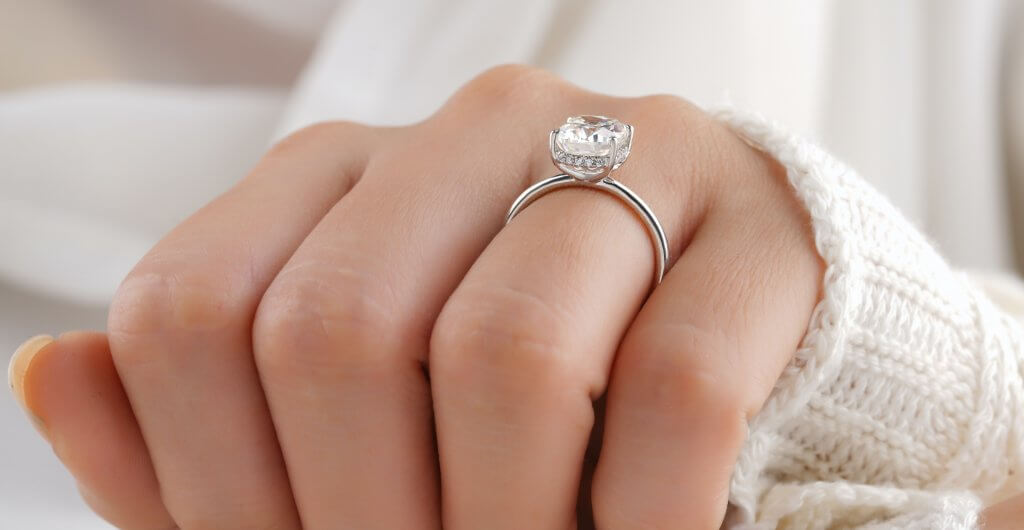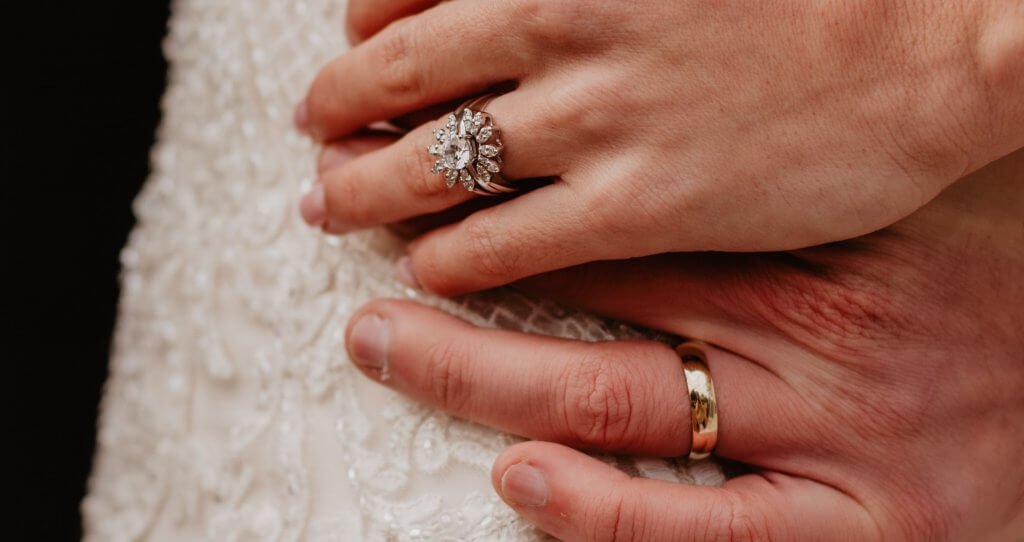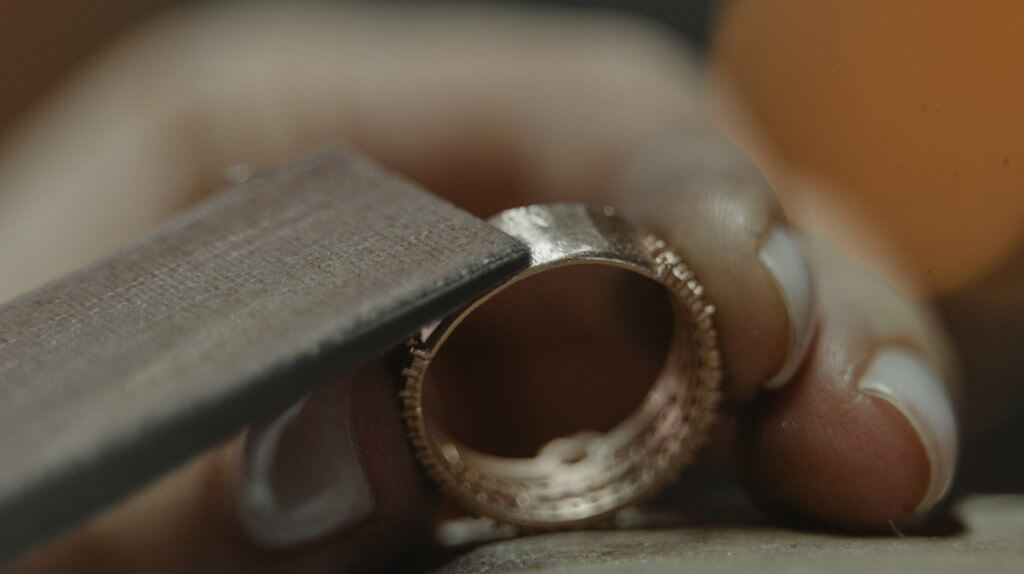White Gold: The Guide
Key Takeaways
- White gold is not a metal in and of itself – it’s the product of gold (which is, of course, yellow) combined with alloying metals that tone down its color, and bring it closer to a silvery hue.
- White gold is almost always dipped in rhodium. This disguises the warm, yellow hint that remains, even after the gold has been alloyed.
- Rhodium plating will need to be replaced every year or so, but this is a quick and easy process.
- White gold is a more affordable option than platinum, although it offers a very similar appearance. It also doesn’t need to be bought at a high karat type, since the objective is to lose that rich yellow hue.

Celestial, elegant and highly complementary to any skin tone, white gold is a popular choice for engagement rings. The prestige of gold is retained, but that distinctively yellow color is swapped out for a dazzlingly bright and modern shine – and one that creates the perfect setting for a brilliant and fiery diamond.
A particularly popular choice among those who would rather not pay the high price of platinum, white gold is an excellent option to keep in mind if your future bride favors silver jewelry over the warmer hues of yellow and rose gold.
What is White Gold?
White gold is a particular alloy of gold, which features a certain amount of nickel and zinc which, together, soften the gold’s natural yellow coloration to something much closer to white. It is plated in rhodium, for additional strength and shine.
One of the most appealing features found in white gold is its unique hue. Alone, this metal appears to be a whitish silver but, if you were to compare it with the dazzling purity of platinum, you would notice a slightly warmer quality to the white gold. This is, of course, down to the high presence of gold, which creates a very vague, yellow undertone many prize.
The nickel and zinc also make white gold significantly stronger than pure gold. It is generally available in 18 karats and 14 karats, with 14 karat white gold representing the stronger and paler of the two.
Is White Gold Real Gold?
It contains real gold. An 18k white gold ring features just as much real gold as an 18k yellow gold ring.
If you’ve read our guide to 24k gold, then you will know already that no engagement ring you see at the jewelry store will be pure gold.
All gold mined from the earth is yellow. A naturally-occurring white gold is as unlikely as a naturally-occurring rose gold. That does not, however, undermine its significance – or the prestige of owning a real gold ring.
Put it this way: if you were to propose to your girlfriend with a gold engagement ring, that would be an alloy – just a different alloy to the one you’d be putting on her finger if you opted for white gold.
Is White Gold Bad?
No – white gold is an excellent choice, and a worthwhile alternative to the more expensive option: platinum.
Some people are deterred from white gold due to the fact that it takes a lot of its color from the rhodium plating, which can rub off over years of wear. This rhodium plating can, however, be replaced (more on that below) without any hassle, and does not detract from the fact that the ring is still formed from precious and highly coveted gold.
The only time white gold is a bad choice is when the intended wearer is allergic to one of the common alloys used in its creation: nickel and zinc.
Why is White Gold So Popular?
White gold offers the beauty, luster, and strength of platinum at a much lower cost, making it the perfect choice for many shoppers looking to invest as much as possible into their diamond.
In any engagement ring, the diamond will inevitably take the lion’s share of any budget – whether you’ve got tens of thousands of dollars to spend, or a more definitive sum. We generally advise that the ring setting – one designed and created by a skilled jeweler – will take around 15% to 20% of the budget, though, obviously, factors like time and materials used will swing it one way or the other.
Platinum is a pretty easy way to drive the cost of even a simple ring design significantly higher – as much as 50% higher compared to the same setting cast from white gold.
And, unless you’re scrutinizing both metals very closely, you’re not going to spot the difference between the two rings, meaning you have the opportunity to invest even more money into your diamond.
For those working to a very specific budget, then, white gold offers a lot more freedom to invest in a higher quality – or slightly larger – diamond.
White Gold Engagement Rings
In theory, white gold is beautiful – it’s strong, bright and a genuine rival to the far more expensive platinum. But how does it shape up to other engagement rings?
D

Is White Gold Suitable for Everyday Wear?
Yes. Unlike pure gold, white gold has been strengthened with alloy, and is far less vulnerable to being scratched, warped, bent, or broken than 24k gold.
You don’t need to worry about a 14k or 18k white gold ring – it can withstand plenty of wear and tear over the years, making it a great option if you don’t want to pay the high price for platinum.
Due to the higher volume of alloy, a 14k white gold ring will inevitably prove that bit more robust and durable than 18k. Plus, while shoppers looking for yellow gold are often eager to preserve as much of the bright, yellow glow of pure gold as possible by opting for a higher karat like 18k, those looking for white gold don’t have that same problem. In fact…
Can You See the Difference Between 14K and 18K White Gold?
No. Both will appear intensely white, and be indistinguishable from one another.
This is down to the rhodium plating used to enhance the color and durability of white gold. It lends an additional, bright sheen to the metal which gives it that distinctively cool, mirror-like appearance.
As we mentioned above, the difference between a 14k and 18k yellow gold is much more significant, and will influence the vividity of the ring. This can lead to many shoppers opting to invest more into their ring setting, in order to capture the brightness of 18k gold alongside the brightness of the diamond.
If you’re looking for white gold, on the other hand, then paying extra for the higher karat isn’t likely to prove worthwhile.
Is White Gold Worth More than Gold?
No, unless the gold is pure.
As we mentioned above, it is simply impossible for you to get ‘pure’ white gold. It doesn’t occur naturally in nature, and can’t be achieved without alloying pure gold with specially chosen metals.
But, if we’re talking about 14k white gold vs 14k gold, or 18k white gold vs 18k gold, white gold is not worth more (or less), and any differences in value between two similar rings will be marginal – and likely down to popularity, more than the market value of the two metals.
Does White Gold Retain its Value?
White gold will generally hold value in the same way yellow gold of the same degree of purity (karat) holds its value.
What do we mean by this? That an 18k white gold will typically be valued the same as an 18k yellow or rose gold, so there’s nothing particularly special about white gold in that regard.
Obviously, pure gold holds the highest market value, but 18k, 14k and 9k gold all show excellent long-term value – provided, of course, that they are properly cared for…
Maintenance
Engagement rings and bridal jewelry are designed to be worn day in, day out, for decades – or even generations upon generations. They need to be strong and robust, but also easy to maintain…
How Do You Maintain White Gold?
Regularly soaking your ring in mild dish soap and warm water will remove any build-up of hand cream, soap, makeup, or dirt that may have begun to dull its sheen over time.
You can check out our full guide to caring for a diamond ring here.
How Long Does White Gold Last?
While a white gold ring will last for many, many years, it will require a new rhodium plating every three to four years, if you intend on wearing it daily.
This is, of course, a very minor task if you want to retain that beautiful, fresh-out-the-box shine of your engagement ring. What’s more, this is actually less upkeep than what is required to keep platinum looking bright and smooth, and a satisfying way to restore than sense of ‘newness’ to your jewelry.
Our Summary: Should You Pick a White Gold Engagement Ring?
It’s an excellent choice if your future bride favors the bright, modern look of sterling silver and platinum, but you’re looking to find the perfect sweet spot between affordability, durability, and beauty.
Sterling silver is softer, and more prone to being bent out of shape. When you take into consideration the fact that your engagement ring will be solely responsible for keeping that $10,000 diamond in place while your fiancée shops, works, rifles through her handbag, rides the subway (and everything else she does in a day), using sterling silver quickly becomes a definitive ‘no’.
This is why platinum is so popular, but it’s also expensive and, even in relatively simple designs, easily pushes shoppers out of their budget.
This is why white gold will always represent a brilliant choice for bridal jewelry. Keeping the prestige of gold, but offering a totally new look for brides that favor brighter metals, it’s a great metal to turn to when you start designing your ring.

Dec 19, 2021 By Willyou.net
10K Gold: A Beginner’s Guide

Dec 24, 2021 By Willyou.net
10K vs 14K Gold: Understanding the Differences








